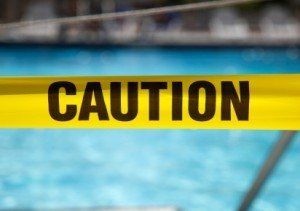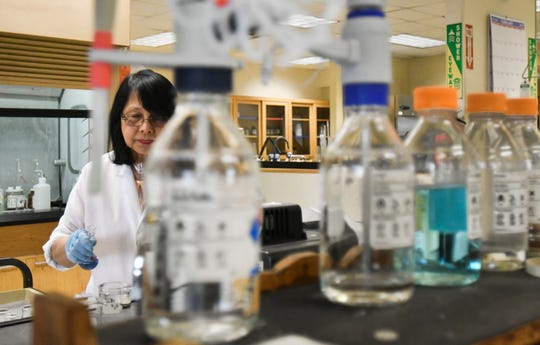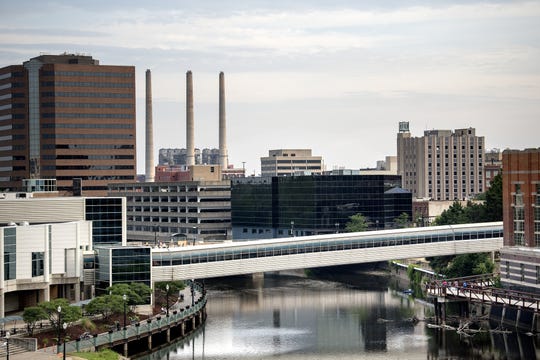Blog Layout
LANSING AMONG STATE'S WORST OFFENDERS FOR SPILLING SEWAGE INTO RIVERS
Engage Team • March 10, 2019
LANSING — It was Dec. 1, and a half-inch of rain had fallen in Lansing, drops that muddied lawns and pooled on pavement, blurred windshields and soaked pedestrians.
Some of the wayward water surged into the city's sewer drain, mixed with the contents of Lansing toilets and contributed to more than four million gallons of sludge spilling into Lansing rivers.
The rain was heavy, but not unprecedented. Neither was the untreated sewage that burbled into area waterways.

A large water pipe that drains into the Grand River near the end of West Ottawa Street in downtown Lansing. (Photo: Matthew Dae Smith/Lansing State Journal)
Lansing's sewer system is consistently among the top overflow offenders in Michigan. In some years, it has spilled more untreated gallons than any other city in the state.
Since 2002, about 8.7 billion gallons of untreated or partially treated sewage water have spilled into the environment in Lansing — billions of gunky gallons potentially laden with bacteria that can make people sick and hurt a river's ecosystem.
The rivers that receive them, the Grand and Red Cedar, are deemed "impaired" by state regulators in part because of high levels of a bacterium found in sewage. At times, the water contains so much bacteria it is unsafe for swimming or partial contact, data show.
Officials restarted a project last year designed to stop the overflows, but the work is still decades behind a state-approved schedule that lists a deadline by the end of this year. City and state leaders are negotiating a new, longer timeline for the project.
Lansing will likely need more than a decade to join more than 60 Michigan communities that already have replaced the aged, leak-prone infrastructure. Until then, potentially hundreds of millions of gallons of sewage-laden water will pour into the city's rivers every year.
One sewer, many problems
Large water pipes that drain into the Grand River near the end of West Ottawa Street can be seen in downtown Lansing. (Photo: Matthew Dae Smith/Lansing State Journal)
In parts of Lansing, sewage and storm water still flow through the same pipes, which the industry calls a combined sewer system. Those combined pipes lead to the wastewater treatment plant on Sunset Avenue, which filters and sanitizes wastewater from the city and some surrounding communities.
The combined sewer system works fine on dry days, when both storm water and sewage get treated at the plant and released into the Grand River, a Lake Michigan tributary that flows from Jackson, through Lansing, Grand Rapids, Grand Haven and out to the big lake.
But on wet days, so much rain and melted snow rush into the pipes that the sewer-storm water slurry spills, usually untreated, into the Grand and Red Cedar rivers and Sycamore Creek before it can reach the wastewater treatment plant.
Lansing Wastewater Treatment Plant soil scientist Deliana McCreary tests treated wastewater samples for iron levels on Feb. 15, 2019. (Photo: Matthew Dae Smith/Lansing State Journal)
Dawn Reinhold, an associate professor in biosystems and agricultural engineering at Michigan State University, described the process with this unpalatable image: A tube connecting a Lansing toilet to a Lansing river.
With enough rain or melting snow "you will actually flush sewage directly into your river," she said.
Besides germs that could make people sick, sewage contains carbon, which degrades river ecosystems by using oxygen in the water and leaving less for fish and other animals, she said. It also carries with it nutrients like phosphorus and nitrogen,which in high volumes can cause increased algae growth and even more oxygen depletion.
If there isn't enough oxygen in a river, fish and other aquatic animals die. There was a fish kill reported in Lansing in 1999, said Gary Kohlhepp, supervisor of the DEQ water resources division's Lake Michigan unit.
Both the Grand and Red Cedar rivers are listed as "impaired" by the DEQ because of their increased levels of E. coli — an organism that indicates the presence of sewage or wildlife waste — and low levels of dissolved oxygen, Kohlhepp said. The rivers have healthy levels of plant and aquatic life.
E. coli is also used by health officials to determine when water is unsafe for swimming or partial human contact. That sometimes happens in the Grand and Red Cedar rivers, Ingham County Health Department river sampling data show.
A view of the Grand River meandering through downtown Lansing on July 12, 2018. (Photo: Nick King/Lansing State Journal)
Kohlhepp referenced a 2012 study that showed levels of E. coli increase as the Grand River meanders into the city's Moores Park neighborhood and downtown.
"Clearly, between where it crosses South Waverly Road and when it gets to Shiawassee [Street], there seems to be a pretty significant jump in E. coli levels," he said.
A 2012 report also showed a similar trend in the Red Cedar River, Kohlhepp said.
Scientists can't point to Lansing's sewers as the only cause of those impairments, since road runoff, pet waste and agriculture and industrial pollution are hard to track and can also pollute waterways.
Still, Kohlhepp is "confident" separating Lansing's combined sewer would improve the rivers' water quality.
Rivers across the country are cleaner now than they were decades ago thanks to federal mandates laid out in the Clean Water Act, Kohlhepp said.
Stopping sewer overflows is one of those mandates, and Lansing is not alone in failing to meet it. EPA reports state combined sewer overflows are a "priority water pollution concern" for 860 municipalities
in the U.S., most of which are in the Northeast and Great Lakes regions.
Inside Lansing's sewers
It's well known to state regulators that Lansing's sewer system is pollution-prone. Dan Beauchamp, DEQ sewer engineering specialist, has listed it among the top three leakiest combined systems in Michigan — in terms of untreated spills — eight times since 2008 in his annual reports.
Lansing's overflow-prone combined sewer system was built in the city's original core: downtown, Old Town and the west and east sides, Lansing Public Service Director Andy Kilpatrick said. Most of the city's south side was developed later and mostly with separated sewers.
"A long time ago, people didn't really care where the sewage went as long as it wasn't in their homes or businesses anymore," he said.
At one time, about 80 Michigan cities had leaky combined systems, Beauchamp said. Lansing is one of 16 that remain, and in some years it's the worst. The capital city nabbed first place for untreated discharges twice between 2008 and 2017, though usually it was outranked by Detroit and Dearborn.
Besides their relic infrastructure, Beauchamp pointed to another similarity between Lansing and other cities with leaky combined sewer systems: the "affordability factor." Separating combined sewers or increasing their capacity to handle major influxes of storm water isn't cheap.
"A [wealthier] city like Grand Rapids was able to go through a combined sewer overflow separation program; they just completed most of their work, " Beauchamp said. "Then there are communities like Dearborn, the city of Detroit, and Lansing, that still have a significant number of [overflows]... Unfortunately, affordability is a big issue for some of these places."
Combined sewer overflows in Lansing
After separating combined sewers under more than 4,000 acres of the city in the mid-1980s, Lansing launched another separation project in 1991, according to a project timeline
published on the city's website.
Crews have separated 71 percent of the city's combined sewers and shrunk overflow volumes by more than half. City officials estimate the combined sewers once overflowed 1.65 billion gallons per year. In 2018, only about 391 million gallons overflowed.
But work stopped in 2012, in part because of the toll it would take on city finances in the years following the the Great Recession, Beauchamp said.
Lansing has spent approximately $210 million on sewer separation since 1992, Kilpatrick said. The project largely has been financed through low-interest state loans but ultimately will be shouldered by rate-payers whose sewer bills have been increased approximately 3 to 4 percent more per year to cover the cost of work, maintenance and operation.
The city pitched a cost-saving idea to the DEQ in 2013 that called for combining the combined sewer overflow work with other water quality projects in a "wet weather control program," according to a Lansing State Journal story published that year.
State and local officials are still hashing out that 2013 plan, Beauchamp said.
"The current schedule that is approved, because of a lot of factors — the recession, the cost issues — that schedule is not going to be achieved," Beauchamp said. "We're in the process of trying to negotiate a new schedule."
Both parties said they are close to agreement, but the years-long pause has put the work far behind schedule to be finished this year, as listed in the current permit.
Pipe dream could come true
There are combined sewers left under more than 2,000 acres of Lansing. Kilpatrick estimated will take 15 to 20 years and another $199 million to separate them.
While fixing the combined sewers is expensive, not fixing the leaky system also carries a financial risk.
DEQ records show the agency fined Lansing $28,750 in 2004 because of excessive overflows in its sanitary sewer system — the one that's usually cleaner. The city's separated sanitary system overflowed 17 times in 2004, spilling at least 9 million gallons. DEQ records indicate the overflows were mostly caused by heavy rainfall.
In its administrative consent order, the department noted "several portions of the Lansing sanitary sewer system continue to experience infrequent SSO/basement flooding occurrences."
Along with the fine, the DEQ ordered Lansing to stop those overflows by 2008.
Sanitary sewer overflows in Lansing
Sanitary overflows have improved but not been eliminated, DEQ records show. Beauchamp said there were six sanitary sewer overflows in 2018, resulting in approximately 38.5 million gallons spilled.
Along with a new permit and timeline, the DEQ and Lansing are brokering another administrative consent order over the city's combined and sanitary sewer overflows, Beauchamp said. He declined to say whether that order would carry another fine.
As officials hammer out the details and negotiate timelines, crews are a year in to the revived sewer separation work
in portions of the Moores Park Neighborhood and neighborhoods near West Mount Hope Avenue and Martin Luther King Jr. Boulevard.
The work should be completed this year, marking another lap in the decades-long race toward cleaning Lansing's sewers.
But 2019 also will be a year of more overflows. The DEQ has already investigated four since Jan. 1, which have resulted in more than 5 million gallons spilled.
Support local journalism and access more stories like this by subscribing to the Lansing State Journal.
Contact Carol Thompson
at (517) 377-1018 or ckthompson@lsj.com. Follow her on Twitter @thompsoncarolk.
March 28, 2023
Lead and Copper Rule Treatment Technique Violations: **Water Quality Parameters Not Meeting Minimum Values** & **Failure to Install Corrosion Control** Our water system violated a drinking water standard and a drinking water requirement. Although this is not an emergency, as our customers, you have a right to know what happened, what you should do, and what we are doing to correct this situation. We routinely sample water at consumers’ taps for lead and copper. In 2015, test results showed lead levels in the distribution system water above the action level (AL). Additionally, a routine inspection conducted in November 2016 by Mississippi State Department of Health (MSDH) found inadequate application of treatment chemicals due to a failing corrosion control system at the O. B. Curtis Water Treatment Plant. As required by Environmental Protection Agency, we were required to take action to correct this deficiency. After testing and analyses of our treatment plants and distribution system, we began installation of optimized corrosion control treatment in October 2017. This treatment prevents lead and copper in pipes and plumbing components from dissolving into the drinking water. During the monitoring periods of 2018 to 2022, we failed to consistently meet treatment technique requirements for our system which is a violation of the Lead and Copper Rule and a requirement of the City’s Optimized Corrosion Control Plan. Corrosion control treatment (CCT) installation was completed at O. B. Curtis Water Treatment Plant but is incomplete at J. H. Fewell Water Treatment Plant due to a reassessment of the Optimized Corrosion Control Treatment (OCCT) plan. What should I do? Although the majority of home lead testing performed identified lead below the action level set by the EPA, MSDH is issuing these recommendations as a special precaution, especially for households with young children or pregnant women. These precautions should remain in place at least six months while the City continues its efforts to make required changes to stabilize the pH levels in its water system that can cause corrosion. Before using tap water for drinking or cooking, run your cold water tap for at least one (1) minute. For details, see http://www.cdc.gov/nceh/lead/tips/water.htm Households should never use the hot water tap for drinking or cooking. Residents should clean out their faucet aerators by unscrewing the aerator at the tip of the faucet and removing any particles or sediment that has collected in the filter screen. Baby formula should be “ready-to-feed” or prepared using only filtered water or bottled water. Parents with children five (5) years or younger should contact their child’s pediatrician or primary care provider to make sure that adequate lead screening and blood testing has been performed. What does this mean? This is not an emergency. If it had been, you would have been notified within 24 hours. Typically, lead enters water supplies by leaching from lead or brass pipes and plumbing components. New lead pipes and plumbing components containing lead are no longer allowed for this reason. However, many older homes may contain lead pipes. Your water is more likely to contain high lead levels if water pipes in or leading to your home are made of lead or contain lead solder. High levels of lead and copper in Mississippi are nearly always due to pipes and fittings in the plumbing. Infants and children who drink water containing lead in excess of the action level could experience delays in their physical or mental development. Children could show slight deficits in attention span and learning abilities. Adults who drink this water over many years could develop kidney problems or high blood pressure. What is being done? We have evaluated and made corrective actions to our existing corrosion control systems to stabilize the pH in the distribution system. The corrective actions are an ongoing process. We have increased monitoring of water quality parameters in the distribution system and at the treatment plants. An amendment to the corrosion control study was submitted and accepted by MSDH in 2021. MSDH has set interim goals for our water system while installation of the recommended corrosion control treatment is pursued. For the July-December 2022 monitoring period, the lead 90th percentile was 6 ppb, which is below the lead AL of 15 ppb. The results indicate that the interim measures to facilitate CCT are working to prevent an AL exceedance on a system wide level while we work to implement optimized CCT. OCCT will be installed and operational by August 2023. For more information, please contact the City of Jackson Water Laboratory at 601-960-2723. “Please share this information with all the other people who drink this water, especially those who may not have received this notice directly (for example, people in apartments, nursing homes, schools, and businesses). You can do this by posting this notice in a public place or distributing copies by hand or mail.” This notice is being sent to you by the City of Jackson PWS ID#: MS0250008. Date distributed: January 19, 2023
March 28, 2023
Boil water notices are issued to all properties that are affected. We routinely monitor your water for turbidity (cloudiness). This tells us whether we are effectively filtering the water supply. If a boil water notice has been issued for your area, please use the following precautions. What should I do? What does this mean? DO NOT DRINK THE WATER WITHOUT BOILING IT FIRST. Bring all water to a boil, let it boil for one minute, and let it cool before using, or use bottled water. Boiled or bottled water should be used for drinking, making ice, brushing teeth, washing dishes, and food preparation until further notice. Boiling kills bacteria and other organisms in the water. Turbidity has no health effects. However, turbidity can interfere with disinfection and provide a medium for microbial growth. Turbidity may indicate the presence of disease-causing organisms. These organisms include bacteria, viruses, and parasites, which can cause symptoms such as nausea, cramps, diarrhea, and associated headaches. The symptoms above are not caused only by organisms in drinking water. If you experience any of these symptoms and they persist, you may want to seek medical advice. People at increased risk should seek advice from their health care providers about drinking this water. What is being done? We are taking steps to ensure the required level of treatment is maintained. The cause of the treatment lapse has been identified and we are making repairs and improvements at the O. B. Curtis Water Treatment Plant to address the issue and decrease the possibility of a repeat occurrence. We will inform you when turbidity returns to appropriate levels and when you no longer need to boil your water. We anticipate resolving the problem within the next 4-7 days. For more information, please contact the City of Jackson Water Lab at 601-960-2723. General guidelines on ways to lessen the risk of infection by microbes are available from the EPA Safe Drinking Water Hotline at 1-800-426-4791.
By Engage Team
•
January 9, 2019
The Flint, Michigan scandal revealed that many water plants in the U.S. contain alarmingly high levels of toxic metals, such as lead. Many municipal water systems add toxic fluoride to the water supply. Fluoride is a known neurotoxin that's been linked to lower IQ scores in children. Fluoride promotes corrosion of water pipes, releasing even more lead and other toxic elements into your tap water. More than 60% of Americans are exposed to lead and fluoride-contaminated water. You might be one of them. Tap water is filled with toxic chloride. The chemical is deliberately added to public water by water treatment personnel to kill bacteria, but it can also affect human health.
By Engage Team
•
December 6, 2018
Michigan is giving Nestle increased access to the state's groundwater supply, even while people in Flint still don't have clean drinking water. If you would like clean, purified water at 2 cents a gallon in every faucet, please contact us through elementfreeinc.com for a free consultation on protecting you and your family. https://www.freep.com/story/news/2018/04/02/michigan-oks-nestle-permit-increased-water-withdrawal-bottled-water-plant/479896002/
By Engage Team
•
December 4, 2018
These flavored waters are healthier than the usual sugary sodas, iced teas and lemonades — but they're a whole lot more exciting than plain old H20. Infused with fresh fruits, vegetables and herbs, they're everything you never knew you wanted in a glass of water. Get the recipes here
By Engage Team
•
December 2, 2018
FLINT, Mich. — By the sunken standards of life in Flint, Kenneth Glover is lucky. Last month, a construction crew arrived at his house, removed the aging, corroded lead waterline leading up to it and installed a new copper pipe in its place. His house became one of fewer than 200 in Flint to have received a new pipe through a city-run program, with thousands more on the waiting list. That matters not a whit to Mr. Glover. He still will not drink the water. “I don’t even give it to my dog,” said Mr. Glover, who works in a General Motors plant, as he stood outside his home last week. “I don’t care how many filters they give us. I don’t care what they say. How can I trust them again?” It has been one year since officials in Flint urged city residents not to drink the water. Since then — as an investigation continues into the failed response at the city, state and federal levels — the authorities have pointed to progress in repairing the city’s lead-tainted water system: Water from the Flint River is no longer used in favor of the city’s former source, the Detroit system, which gets water from Lake Huron. https://www.nytimes.com/2016/10/09/us/after-water-fiasco-trust-of-officials-is-in-short-supply-in-flint.html

By Engage Team
•
November 12, 2018
Can taking a shower really be dangerous? It may come as a shock, but the very method most people use to keep their bodies clean could be exposing them to unforeseen health risks. Soaking up water in this way is especially dangerous because the chlorine goes directly into your bloodstream . This means you absorb 6 times more chlorine per glass while showering than if you were drinking the same water. The Dirty Truth About Your Shower Water Research presented at the American Chemical Society in 1986 demonstrated that showering leads to greater exposure to toxic chemicals in tap water than drinking the water does. The dangers and risks of chlorine exposure are serious — including, but not limited to… Irritation of the eyes, sinuses, throat, and skin Aggravation of the lungs Excessive free radical formation, which results in accelerated aging Hardened arteries Difficulty metabolizing cholesterol Higher vulnerability to genetic mutation Development of cancer In a recent article in The American Journal of Public Health, chlorine was linked to measurable increases in certain types of cancer. The article also reported that up to 2/3 of our harmful exposure to chlorine is through absorption by the skin during showering. Even if you can’t detect the presence of chlorine in your water via smell or taste, that doesn’t mean you’re safe from the consequence of exposure. Chlorine exposure can be especially harmful for individuals with pre-existing conditions such as sinus conditions, allergies, skin rashes, emphysema and asthma. Got Chloroform? The most current findings from the U.S. Environmental Protection Agency (EPA) indicate that virtually every home in America has a detectable level in the air of chloroform gas — a derivative of chlorine and a known carcinogen — due to chlorine and showering. Anyone who showers regularly should be concerned about the dangers of chlorine exposure, but especially those who suffer from dry and irritated skin; damaged and brittle hair; flaky or itchy scalp; or redness and burning of the eyes. Dr. John Andelman, Ph.D., says the dangers of exposure to chlorine during showers via absorption through the skin as well as inhalation cannot be overstated. Andelman is especially concerned with the high concentrations of chlorine and synthetic chemicals that can enter the body this way. Experts used to believe that ingestion was the primary method of chlorine intake, but new studies show that inhalation and skin exposure intake are even higher. One of the most prevalent forms of chlorine taken in through inhalation is chloroform. Remember, chloroform is a carcinogen, and it’s also linked to excessive free radical formation, cell mutation, and the oxidation of cholesterol. As Dr. Mercola explains, when we inhale chloroform, it goes directly into our bloodstreams without any kind of preliminary detoxification. So unless you are regularly taking minute-long showers in cold water, “your body is like a sponge for these airborne toxins every second you spend in the shower,” says Mercola. How to Protect Yourself from the Hazards of Chlorine Obviously, avoiding showers altogether is not an option. There’s a far better (and simpler) solution — and that is … to get the chlorine out of your water. The best way to eliminate chlorine and its hazardous derivatives from your water supply is to install a whole house water purification system from www.elementfreeinc.com . These filters are widely available and easy to use. They attach directly to the faucet, and are capable of removing not only chlorine but also other chemicals such as water-soluble lead, mercury, nickel, chromium, iron, and other metals. These filters remove more contaminants than any other method, and also enhance the water’s pH balance. The best way to protect your body — inside and out — from the chemicals and volatile organic compounds (VOCs) that you are exposed to when showering in water drawn from the municipal water supply is by using a filter. Please contact www.elementfreeinc.com for a whole house water purification system to help you and your family eliminate this exposure.
By Engage Team
•
November 7, 2018
The United States uses 42 billion gallons of water a day to support daily life from cooking and bathing in homes to use in factories and offices across the country. Around 80% of drinking water in the U.S. comes from surface waters such as rivers, lakes, reservoirs, and oceans, with the remaining 20% from groundwater aquifers. In total, there are approximately 155,000 active public drinking water systems across the country. Most Americans – just under 300 million people – receive their drinking water from one of the nation’s 51,356 community water systems. Of these, just 8,674 systems, or approximately 17%, serve close to 92% of the total population, or approximately 272.6 million people. Small systems that serve the remaining 8% of the population frequently lack both economies of scale and financial, managerial, and technical capacity, which can lead to problems of meeting Safe Drinking Water Act standards. https://www.infrastructurereportcard.org/drinking-water/conditions-capacity/
By Engage Team
•
October 23, 2018
Each year, red flags over toxic drinking water are raised across the nation, with reasons varying from location to location. As reported by The Atlantic, aging water pipes have become an increasingly common source of toxic exposure. While the article describes the situation in Flint, Michigan, many other areas around the US struggle with similar problems: "... [A]bnormally high levels of e. coli, trihalomethanes, lead, and copper have been found in the city's water, which comes from the local river (a dead body and an abandoned car were also found in the same river) ... [R]esidents say that the city government endangered their health when it stopped buying water from Detroit last year and instead started selling residents treated water from the Flint River ..." In December 2015, Michigan Governor Rick Snyder apologized for the state's mishandling of the situation in Flint, and Dan Wynant, head of the state Department of Environmental Quality, resigned. The state has now allocated $10 million to water testing and distribution of water filters.
By Engage Team
•
October 5, 2018
Clean, pure water is essential for health, and I strongly encourage you to filter the water you use both for drinking and bathing. In fact, immersing yourself in contaminated water may be even more hazardous to your health than drinking it, as the chemicals absorbed through your skin go directly into your blood stream, bypassing your digestive and internal filtration systems. The Environmental Protection Agency (EPA) regulates tap water in the U.S., but while there are legal limits on many of the contaminants permitted in municipal water supplies, more than half of the 300+ chemicals detected in U.S. drinking water are not regulated at all.4 According to Paul Pestano, a research analyst with the Environmental Working Group (EWG), some of the legal limits may also be too lenient for safety. For several years, the EWG has argued that the federal government needs to perform a nationwide assessment of drinking water quality, and invest more to protect against water pollution in the first place. So far, it has done neither, which led the EWG to create its own drinking water quality database,5covering 48,000 communities in the U.S. Among the top rated water utilities are Arlington, Texas, Providence, Rhode Island, and Forth Worth, Texas. At the bottom of the list are Pensacola, Florida, Riverside, California, and Las Vegas, Nevada.




